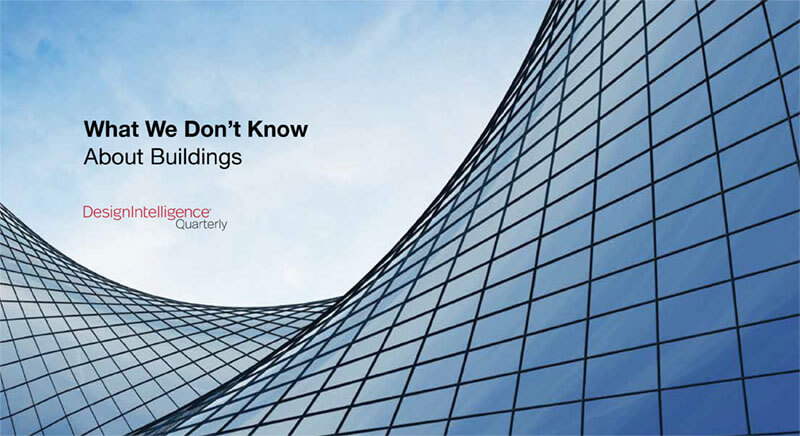What We Don’t Know
About Buildings
by Scott Simpson
Senior Fellow, DesignIntelligence
The design, construction and ownership communities are overdue for adoption of data-informed processes. When will we join the rest of the business and scientific fields?
People spend the vast majority of their time in buildings, and since every aspect of the built environment is designed, manufactured, installed and operated by human beings, you’d think we know pretty much everything there is to know about how architecture affects our daily lives. But that’s far from true. We’re just beginning to understand how little we know.
A case in point is the emerging interest in “evidence-based design” increasingly used in healthcare facilities. It seems self-evident that brighter colors and more natural light will make for a cheerier environment, and perhaps may be therapeutic in some way. The healthcare industry is awash in all kinds of data (statutory requirements for extensive record keeping are often cited as a significant source of frustration—and medical error—by physicians), but we have yet to turn that data into a deep understanding that underpins safer and more cost-effective outcomes for patients across the board. How do we know this? Because despite the best intentions and huge amounts of money spent annually on healthcare in the US (the most expensive in the world on a cost per capita basis), the system does not yet deliver some basic results we should be able to take for granted. (As one example, the infant mortality rate in the US is 5.9 per 1000 births, compared with 3.9 in other OECD countries.) Clearly, something is amiss. How much does this have to do with the way medical facilities are designed and operated? We just don’t know.
We do know designing with data in mind can lead us in new directions. The advent of autonomous vehicles has created a bumper crop of data analytics, and even conventional vehicles are now equipped with a broad array of data collection devices. Information about speed, fuel consumption, and battery life are just the basics—our cars are now talking to us about traffic conditions and road hazards, plotting the most efficient travel routes, telling us when we need an oil change or a new set of tires. Real-time data collection can even track individual driving habits and lower insurance rates for careful operators. Our cars can pay our tolls for us, and data driven services like Uber or Lyft hold the potential to radically reduce traffic congestion and the need to build parking garages. Autonomous driving, once considered to be in the realm of science fiction, is likely to have a profound impact on how cities are designed and built in the future.

Why not apply this same approach to architecture as well as cars? That would be a game-changer. Too often architects think about buildings primarily as “place making”—static containers that enclose habitable space. However, what’s important is what happens inside buildings—that’s literally where the action is. Thinking about the places and their processes together will open new doors and lead to a deeper understanding of how architects can create significant additional value for owners and users alike. That’s when design thinking becomes strategic rather than transactional.
A good example of how architecture can impact outcomes is the recent spate of STEM buildings constructed at college campuses across the country. There’s more focus on cross-pollination among the basic scientific disciplines (physics, chemistry, and biology); more open labs with bench space and equipment arranged to accommodate team-based project work; more experiential, hands-on learning rather than focusing just on texts or memorizing the periodic table. As a result, new STEM labs are more open, more interactive, and more geared to multi-media teaching and learning. Not surprisingly, the number of STEM majors has increased substantially, grade point averages are rising, and new graduates are securing well-paid employment in a wide variety of related industries, from engineering to healthcare to biotechnology. All this is rooted in a deeper understanding of how architecture can enhance success in STEM curricula. It’s a marriage of place and process.
Design thinking is not limited to healthcare projects or STEM labs. “Process design” can be applied anywhere at any scale. For example, in a typical office building, where do people spend their time? How much (and what kind of) activity takes place at an individual’s desk, and how much on the phone, in a conference room, or at the coffee machine? Which kind of activity is the most productive, and are there ways to design office space that will measurably enhance communication, collaboration, and teamwork? Over the past few years, there has been a clear trend toward more open office environments, but what do the data tell us? What is the ideal ratio of spaces for privacy and community? Why do so many conference rooms sit empty most of the time? What are the ideal seating arrangements for mixing executives and general staff? Are companies with open offices more profitable. If so, why?

The answers to questions like these will lead designers in interesting directions. For example, what role does design play in public health? How can civic spaces be designed to enhance safety and reduce crime rates? How can correctional facilities be designed to reduce recidivism rates? Why is the risk of acquiring an infection so much higher in a hospital than an airport, and what can be done about it? Could schools be designed so that student safety can be taken for granted? The questions—and the opportunities—are endless.
In thinking about issues like these, it should be obvious that “design” is not limited to plans, sections, and elevations. It invites (and requires) broad expertise in sociology, science, business, logistics, manufacturing, information technology, transportation, and other fields. Because buildings are the source of 46% of carbon emissions annually, knowledge of materials science is also a critical factor. This opens new territory for designers to have a positive impact, since everything we make, consume, and discard is designed in some way.
The implications are clear. Architects need to care as much about how things work as how things look. And they need to know more. When that happens, the sky is the limit.


